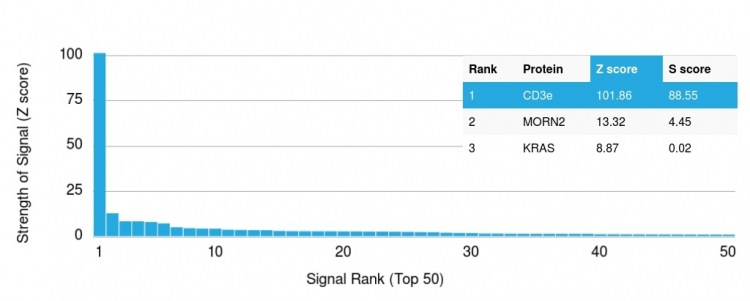CD3 epsilon antibody [UCHT1] (PerCP)
GTX79855
ApplicationsFlow Cytometry
Product group Antibodies
TargetCD3E
Overview
- SupplierGeneTex
- Product NameCD3 epsilon antibody [UCHT1] (PerCP)
- Delivery Days Customer9
- Application Supplier NoteFACS: 10 microl reagent / 100 microl of whole blood or 106 cells in a suspension. *Optimal dilutions/concentrations should be determined by the researcher.Not tested in other applications.
- ApplicationsFlow Cytometry
- CertificationResearch Use Only
- ClonalityMonoclonal
- Clone IDUCHT1
- ConjugatePerCP
- Gene ID916
- Target nameCD3E
- Target descriptionCD3e molecule
- Target synonymsCD3e antigen, epsilon polypeptide (TiT3 complex); CD3e molecule, epsilon (CD3-TCR complex); CD3-epsilon; IMD18; T3E; T-cell antigen receptor complex, epsilon subunit of T3; T-cell surface antigen T3/Leu-4 epsilon chain; T-cell surface glycoprotein CD3 epsilon chain; TCRE
- HostMouse
- IsotypeIgG1
- Protein IDP07766
- Protein NameT-cell surface glycoprotein CD3 epsilon chain
- Scientific DescriptionThe protein encoded by this gene is the CD3-epsilon polypeptide, which together with CD3-gamma, -delta and -zeta, and the T-cell receptor alpha/beta and gamma/delta heterodimers, forms the T-cell receptor-CD3 complex. This complex plays an important role in coupling antigen recognition to several intracellular signal-transduction pathways. The genes encoding the epsilon, gamma and delta polypeptides are located in the same cluster on chromosome 11. The epsilon polypeptide plays an essential role in T-cell development. Defects in this gene cause immunodeficiency. This gene has also been linked to a susceptibility to type I diabetes in women. [provided by RefSeq, Jul 2008]
- Storage Instruction2°C to 8°C
- UNSPSC12352203
References
- Selective targeting and timing of matrix metalloproteinase inhibition in post-myocardial infarction remodeling. Yarbrough WM et al., 2003 Oct 7, CirculationRead more



![FACS analysis of human PBMC cells using GTX10869 CD3 epsilon antibody [CA-3]. Blue : Primary antibody Green : Isotype control Red : Cell only control Antibody amount : 1microg/1x10? cells for 30 min at 20oC](https://www.genetex.com/upload/website/prouct_img/normal/GTX10869/GTX10869_20190815_FACS_w_23060120_666.webp)

![FACS analysis of Jurkat cells using GTX80237 CD3 (activation epitope) antibody [APA1/1] (PE)](https://www.genetex.com/upload/website/prouct_img/normal/GTX80237/GTX80237_FACS_20181219_w_23061322_428.webp)
![FACS analysis of Jurkat cells using GTX83278 CD3 epsilon antibody [4E2]. Green : CD3 epsilon Purple : negative control](https://www.genetex.com/upload/website/prouct_img/normal/GTX83278/GTX83278_20170912_FACS_w_23061322_992.webp)